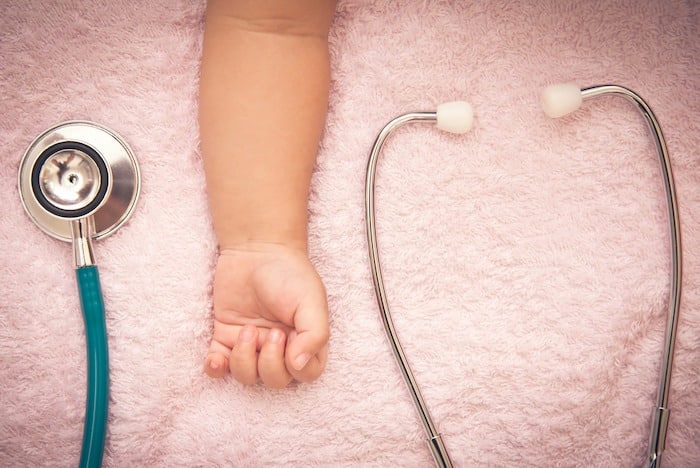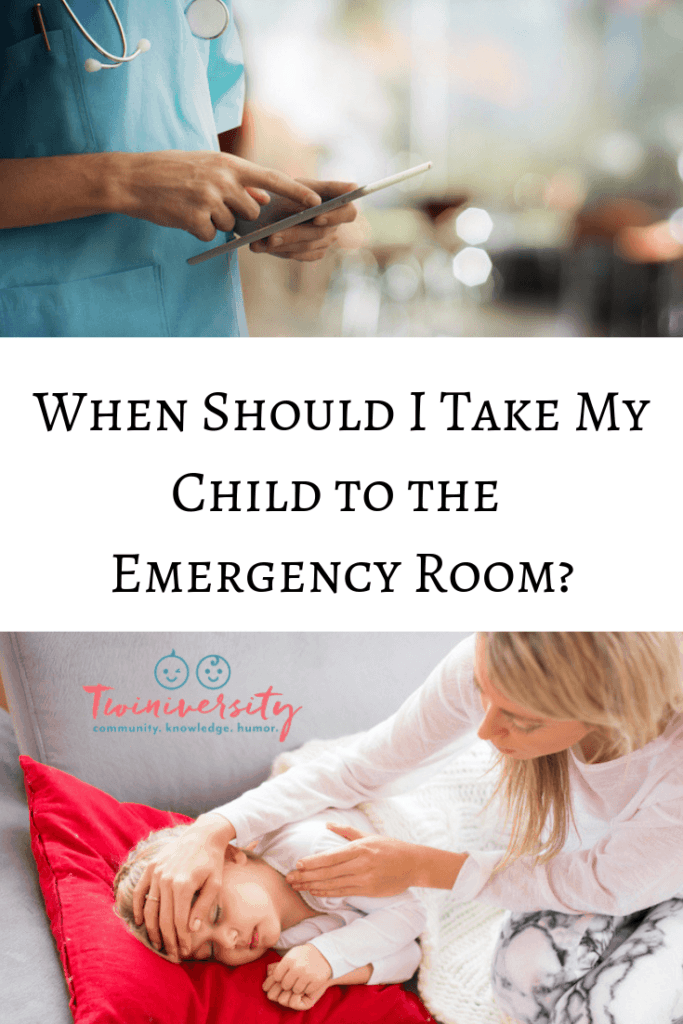Last updated on November 10th, 2023 at 04:26 pm
Hey guys! I’m Gwenn: Full-Time mama, part-time nurse. I have over 10+ years experience in the emergency room and have seen my fair share of pediatric emergencies. I also have 9+ years of being a mama to my five little ones, including a set of twins. I always say when all else fails, go with your mommy gut feeling because it’s usually correct! I hope in this article to educate you and share some inside information on the nurse end that will hopefully help you when your debating on what to do and when that “Oh crap” moment happens. Let’s jump into some scenarios.

Head Trauma
First, lets start at the top! Little Johnny, who is 2, takes a tumble off the bed and WHAM, lands right on his head. Immediately you notice a goose-egg appearing and his screams are so loud it would wake the dead. The emergent signs that would indicate true head trauma and heading to the ER would be:
- vomiting
- lethargy to the point that’s not normal
- irritability and
- loss of consciousness on impact
I would say 99.9% of head injuries from a fall result in nothing and, honestly, most facilities do not push for CAT scans of the head due to the amount of radiation to the child. We can’t see concussions on CAT scan, they are diagnosed by symptoms only. So many people come in “just in case I/ they had a concussion” but there is nothing physical that can prove you had one. Just a little tidbit for ya! Some ice and weight-based Tylenol is usually what it takes to help aid that little goose-egg back to health.
Skin Injuries
Now let’s talk about skin. I’m going to address rashes and lacerations. These are two huge reasons people often bring their children to the hospital. There is such a broad spectrum for rashes and it can be so tricky to treat. Your baby goes down for their nap totally normal then wakes up with a speckled, red rash over her torso and thighs. It doesn’t seem to be bothering her but by golly, it looks horrible. Or, you pick up your teething 10-month-old from daycare where everything goes into the mouth. You see some red dots on his hands and feet and he seems irritable and may even have a low-grade fever. These are both classic examples of viral rash: Viral exanthem and Hand, foot, mouth.
The other rash that may develop is an allergic rash which you can start medicating at home with Benadryl. Most of these allergic reactions are minor but if that mom gut is telling you it’s more involved then come get checked and head to the ER. Moderate allergic reactions typically only require some non-invasive monitoring and steroids.
Now your outside swimming and your 5 year old decides to run around the pool chasing the dog where it is all slippery and down he goes, gashing open his chin (this is a true story, ha!) If a wound is gaping open, it more than likely needs sutures or staples and its time to head to the ER. Apply pressure immediately and wrap up the wound. The ER is going to ask about tetanus shots so be ready. Most ER’s also have the plastic surgery team on call for those fun facial lacerations, you just have to request to see them.

Bone Breaks
Bones, bones, and more bones. Kids are so resilient. If they refuse to move it or won’t bare weight, head to the ER to get it checked because there is usually a reason for it. I would say arm bones are the most common fractures I see. Rarely legs and ankles are broken unless there is a large fall or trauma. If there is a true non-displaced fracture, I will put a temporary splint on and have you follow up with an orthopedist.
Vomiting
Oh the dreaded 3 am puke session. Why is it always in the middle of the night? Little Anna woke up crying covered in her vomit. This fun vomiting adventure continues into the morning lasting a few hours. There is usually no need to panic and run to the ER. As gross as it is, a lot of gastrointestinal (GI) bugs only last 6-12 hours and then are usually gone. I always encourage parents to introduce water or an electrolyte liquid super-duper slowly. Do not even try food for those first few hours. Trust me, your child will not starve to death by missing a meal or two. The main focus should be small sips of liquid slowly and keeping an eye out for peeing amounts or wet diapers.
If your day does end up in the ER, as a nurse, I will ask the last time they peed because this really lets us know if they truly are dehydrated. A urine sample can give us insight into how dehydrated they really are. Kids can dehydrate quickly so if it’s been hours and they are still not able to keep liquids down or are acting lethargic, please get checked and head to the ER. I would say typically I give an oral nausea medication in the ER to my pediatric patients that help them get over that hurdle and get you and your little one back on your feet.

Diarrhea
Diarrhea is rough. Typically though, as I mentioned above, most GI bugs are quick in and quick out. As the parent, encourage extra fluids (assuming they aren’t vomiting) because kids lose so many electrolytes with diarrhea. This symptom can be from a number of different things: Teething, influenza B, allergies, GI bugs — the list goes on and on. I would recommend you calling your pediatrician and seeing if they recommend any over the counter medications to try.
If your child becomes lethargic or isn’t consuming fluids to make up for the diarrhea loss, you need to get checked out. I will try to collect a stool sample in the ER for a culture and if your child is symptomatically dehydrated, they may require IV fluids.
Fevers
Fevers are a whole article in and of themselves. The one huge thing I am going to say is please medicate your child. Every single day I check in children in triage with a 103 + temps and of course the child is miserable. The parents reply is “well I wanted you to see how high it was.” Honestly, we believe you. If you say your child’s temp was 103 at home and you gave them Tylenol prior to coming in and now its 99, we appreciate it! We will treat and assess you just the same. Its not worth them having a febrile seizure.
What to Do in the ER
OK, you made the decision to get checked by a medical professional. Here are the basics.
Parent to Parent, the most you can do is help us and stay calm. I know it sounds basic right, but trust me, I am well aware the ER is the last place you probably want to be or planned to be. I’m a true believer that your child can sense your anxiety and fear. Take some deep breaths and put on a happy face for the next few hours.
Depending on the age of your child, I may have to hold down or papoose your child so we can ultimately help them. Talking to your child and informing them what’s about to happen and that I am there to help them get better goes a long way. An involved parent that steps up and helps is my favorite type of parent.
I hope you got some inside information in this article, and know that your medical professionals are always there to help you.
Related Articles
- Our First Trip to the ER as New Parents
- Making Doctor Visits a Positive Experience For Your Kids
- The Doctor is In: 8 Tips to Fight a Stomach Virus








